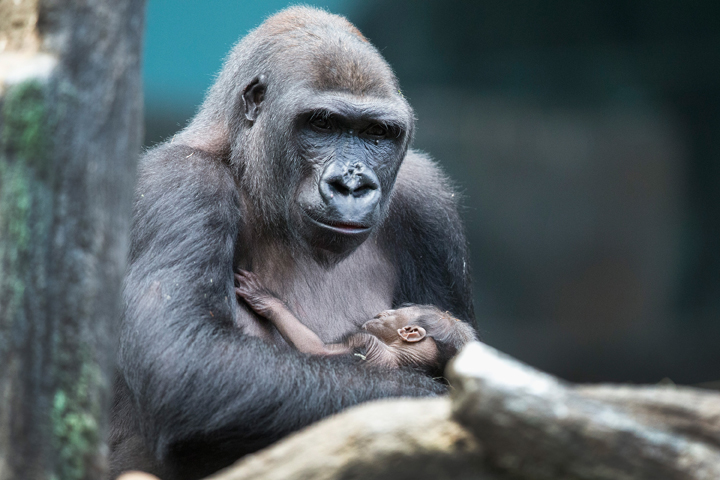While the actions of Harambe, the gorilla who was shot to death at the Cincinnati Zoo on May 28 after a boy fell into his enclosure, may have seemed violent, gorillas aren’t known for their aggression, according to experts. In fact, they are considered calm and gentle.

Following the incident, which garnered international attention, many people expressed outrage. Many attacked the mother on social media, accusing her of being negligent. And many more have commented on Harambe’s behaviour, with some misconceptions.
WATCH: Witness captured video of Gorilla grabbing and dragging around child at Cincinnati Zoo

Gentle giants
“We know remarkably little about their behaviour in the wild,” said Shawn Lehman, who’s on the board of directors at the Jane Goodall Institute, and a professor of anthropology at the University of Toronto. “But from the preliminary information we have, they are remarkable, peaceful creatures.”
READ MORE: Harambe’s death: Is the parent-shaming over gorilla’s death going overboard?
“They spend a good majority of their time just resting, relaxing and interacting with each other primarily around the silverback … They are, by all accounts, remarkably sedate animals given their size, their power, and the size of their teeth.”
However, it’s the silverback who rules the group. Socially, the members of the group centre their actions and activity around the male. And the male (referred to as the silverback due to its colouring), will sometimes assert himself with other males with demonstrations. The actions could be thrashing through the bush, grabbing things, pulling another individual and even dragging them.
And this was what Harambe could have been doing. But when you consider that a male gorilla weighs — on average — 400 pounds, and that we are significantly smaller and weaker, it appears violent.
WATCH: Koko the gorilla adopts two kittens into her family
“It’s very terrifying to us … but when you appreciate the full strength of these animals you realize how they’re really mediating what they’re doing,” Lehman said. “They’re displaying; it’s not designed to destroy. It’s designed to show power and dominance.
“They’re remarkably sedate animals,” he said. “They’re often referred to as the ‘hippies of the ape world.’ They’re really chill, really cool, the juveniles can be hilarious. But the male’s job is to maintain dominance.”
As for the Cincinnati incident, Lehman emphasized that it’s difficult to determine with certainty what the gorilla was doing in that short video. But he believes that Harambe’s behaviour was that of a typical male gorilla asserting his dominance. A juvenile gorilla could take that type of behaviour, but not a human child.
READ MORE: ‘A senseless tragedy’: Cincinnati Zoo’s killing of rare gorilla to rescue boy sparks outrage
Because gorillas’ social lives centre around that of the male, Harambe’s death will likely be difficult for the remaining gorillas.
“It can be a hugely traumatic experience for the females,” Lehman said. One of the reasons is that they are very attached to the silverback. Another male might come in and not be so gentle or accepting of them.
Gorillas are also highly empathetic. In 1996, at the Brookfield Zoo outside of Chicago, Illinois, a three-year-old boy fell into the gorilla enclosure. A female gorilla cradled him and then took him to a door for handlers to take him.
WATCH: Gorilla Carries 3-Year-Old Boy to Safety in 1996 Incident
Highly intelligent
“These are all really intelligent animals and all have their own personalities,” said Lehman.
While the size of a gorilla’s brain is small compared to that of a human, gorillas are highly intelligent. It was once believed that they didn’t use tools, but now we know that’s not the case. They are able to perform complex problem-solving and mental-mapping of their environment.
In 2012, researchers working in Volcanoes National Park in Rwanda even filmed gorillas dismantling snares set by poachers.
Critically endangered
Western lowland gorillas are listed as critically endangered on the International Union for Conservation of Nature’s (IUCN) Red List. They are considered one of two subspecies of the western gorilla, which also includes the cross river gorillas.
Critically endangered, IUCN states, means that there has been a “population reduction of more than 80 per cent over three generations.” However, it’s believed that the population of the western lowland gorilla has declined by more than 60 per cent over roughly 25 years. Though poaching is illegal, it hasn’t stopped the practice, which has contributed to their rapid decline. Gorillas living in remote areas face another threat: ebola. According to the David Suzuki Foundation, some scientists estimate that the deadly disease has killed about one-third of the gorilla population, hitting the western lowland gorillas hardest.
There are numerous conservation efforts underway by numerous agencies, including the Jane Goodall Institute, the WWF and The Gorilla Foundation, with the hope that some day these intelligent, majestic creatures can once again thrive in their natural habitat.



Comments